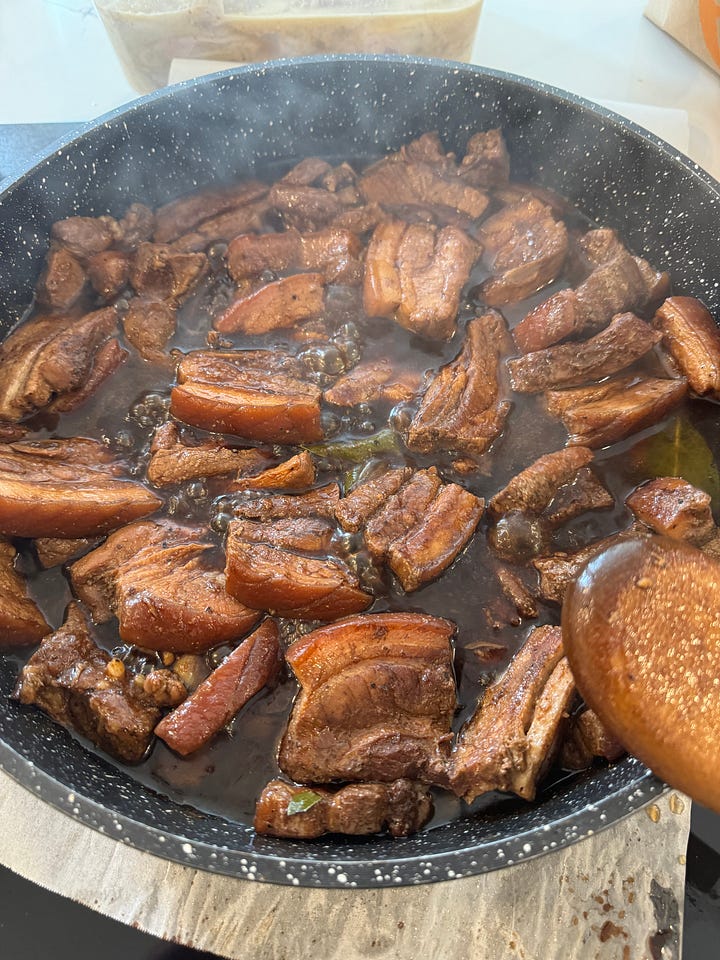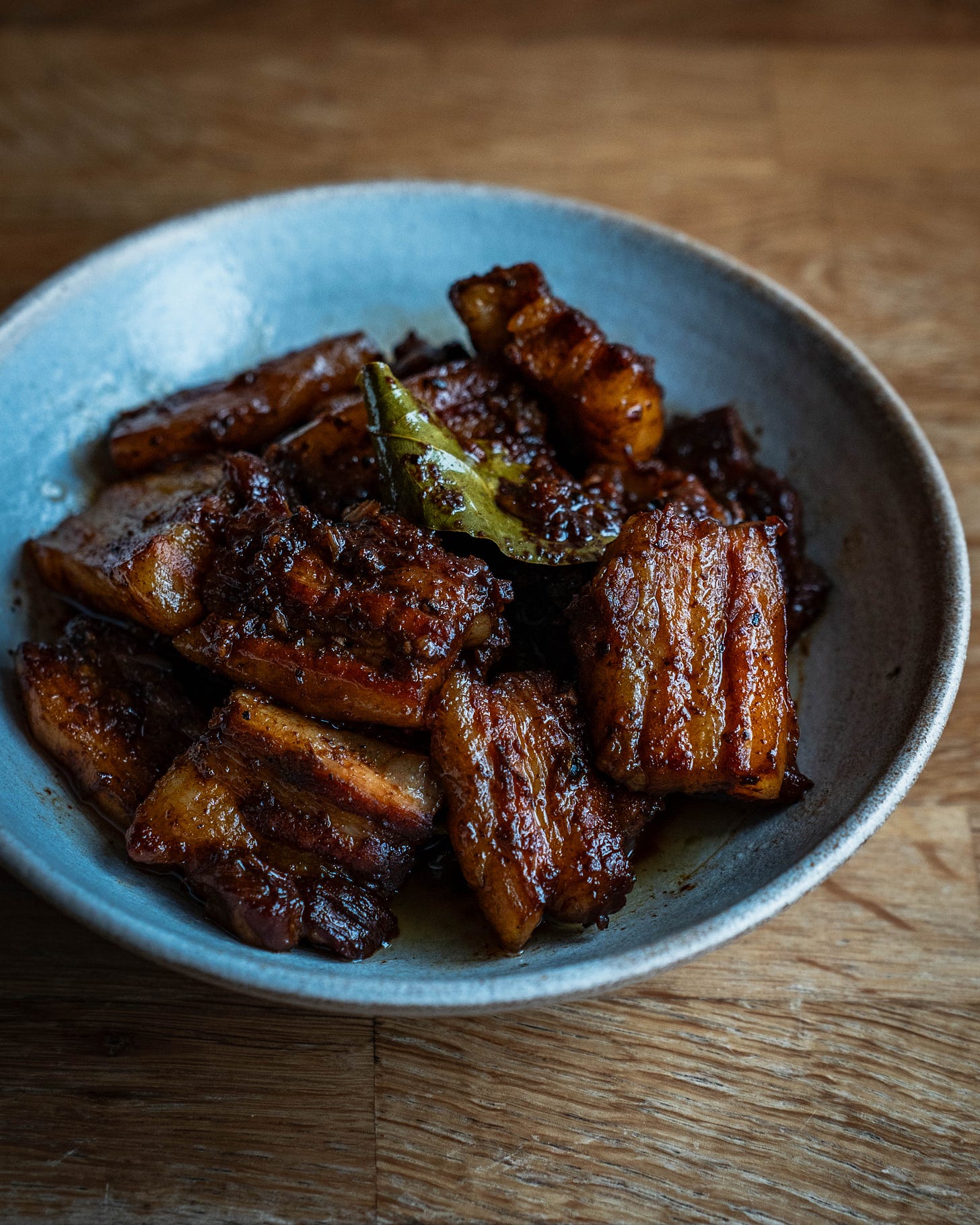For the uninitiated, Filipino adobo might be the most delicious dish you've never tried. Typically, it consists of meat seared in fat and then braised in vinegar, soy sauce, sugar, garlic, black pepper and bay leaves. It is a humble dish, requiring simple ingredients and little preparation.
It is also astonishingly tasty, the type of dish that will leave you gobsmacked at how good a single mouthful of food can be. It shouldn’t be hard to see why; good things happen when you take forceful expressions of saltiness, sourness, and sweetness and blend them together with a boatload of garlic and seared meat.
I always think about adobo more around this time of year. It reminds me of Christmas at home in Sydney, where my mum’s delicious adobo has been a yearly centrepiece.
Whilst I grew up eating mostly chicken adobo, the other year, when I was back at home, my mum made a version with pork belly, where she cut the meat into elongated, thickish strips. It was amazing, and it has since become my favourite way to cook the dish. The recipe I’ve provided below is my own take on it.


Adobo — a short history and overview
Adobo is less a dish and more broadly a cooking technique that encompasses the cooking of foodstuffs in vinegar.
The name adobo is linked to the Spanish words adobar (to pickle), adobo (a pickling sauce of vinegar, olive oil, garlic, majoram amongst other things) and adobado (a dish of pork preserved in adobo pickling sauce).
Despite the etymological links to Spain, adobo, or the practice of stewing and preserving foods in vinegar, is a native Filipino dish that predates Western colonialism. Local inhabitants of the region would stew a great diversity of proteins in vinegar to ensure preservation in the hot and humid climate.
Then, in 1613, amidst the Spanish colonization of the region, a friar named Pedro de San Buenaventura tasted a local adobo-like dish and dubbed it 'adobo de los naturales' (adobo of the natives) due to its similarities to Spanish adobo foods— henceforth its local name was lost in history, and a new moniker emerged.
Whilst the most popular and recognisable adobo is likely that of chicken or pork, stewed in soy sauce, vinegar, and garlic - a great degree of variation exists within this dish.
There are versions made with coconut milk, annatto oil, with just salt in lieu of soy sauce; I have even read about versions made from monitor lizard and snake, and there exist primitive vegetarian variations made from morning glory and eggplant.
But such variations are beyond my knowledge or experience, so until I return to the Philippines with a keener eye and a more adventurous tongue, I'm sticking to what I know best! So, without further ado, please find my recipe for pork adobo below.
Pork Adobo Recipe (serves 3)
Ingredients
Pork belly, 500g
Light soy sauce, 80 ml
Water, 100 ml
White vinegar1, 100 ml
Brown sugar, 1 tbs
Garlic, 6 cloves (roughly chopped)
Black peppercorn, 1 tbs roughly grinded
2 bay leaves
Water to cover
Method - Long Version
Remove the skin of the pork belly and cut away the rib bones (if there are any). You can use the skin to make chicharrón.
Trim the pork belly and portion it into pieces with a nice equal layering of lean meat and fat (like in the image below). It helps to eye out the pork belly at the butcher and select a section of it which has good proportions of meat and fat.
Cut the pork belly into strips that are about 6cm long by 1.5cm wide.
Place the pork belly into a Tupperware, bowl or ziplock bag and add the 80ml soy sauce and 100ml of water. Then leave for a minimum of four hours and a maximum of 24 hours.
When you’re ready to cook the adobo, take the pork belly strips out of the soy sauce water solution and dry each one individually so that it is as dry as possible.
In a hot wide pan (I used a saute pan), hold a piece of pork belly fat side down and smear the fat around the pan for about 30 seconds until the whole surface of the pan has a little rendered prok fat covering it. Then, place pork belly strips into the pan, ensuring none are touching another. Sear on one side, then flip and remove once the other side is seared. Remove all the pork into a bowl and set aside.
You should now have a lot of rendered fat in the pan. Remove most of it, but leave a little in there to saute the garlic. Add the garlic and saute for a few minutes until fragrant.
Into the pan, add the soy sauce-water brining solution, sugar, bay leaves, black pepper, and pork. Then, add enough water so the pork is just covered (or at least 90% covered).
Bring to a boil, then reduce heat to low and cover the pan and cook for 1 hour.
Remove the cover on the pan, then add the vinegar and let the adobo simmer uncovered until your desired consistency. This adobo suits a more dry style so I judge that it is done when there is a small bit of fatty sauce coating the bottom of the pan.
Serve with jasmine rice! I also always have mine with cucumber, tomato, red onion salad dressed in a little fish sauce and lemon juice.
Method - Long Version
Remove skin of pork belly
Cut pork belly into strips that are around 6.5cm long by 1.5cm wide
Brine pork belly in soy sauce and water for 4 hours or overnight
Pat pork belly dry
Sear pork belly on either side, remove and set aside
Remove most of the rendered fat in the pan, save for a little, then saute garlic for a few minutes
Add pork belly, soy sauce-water brining solution, bay leaves, sugar and pepper and just enough water to cover and bring to a boil before reducing heat to low, covering with a lid and cooking for 1 hour
Remove lid, add vinegar and cook for a further 10 minutes.
Finish cooking when there is a thick sauce that just coats the bottom of the pan
Filipino ‘Datu Puti’ brand sugar cane vinegar is typical. It has its own distinct taste, so if you can find it at your local Asian grocer, Filipino speciality store, or Amazon - it’s worth seeking out. If not, use distilled vinegar or white rice wine vinegar and you’ll still end up with a great dish.













Can't wait to try this! 💙